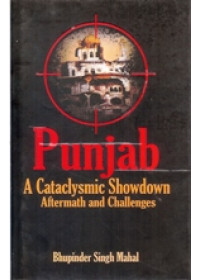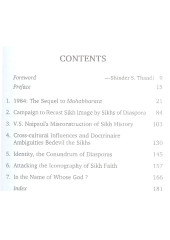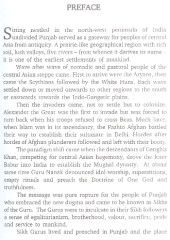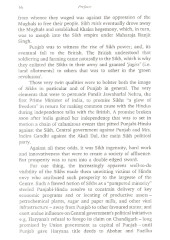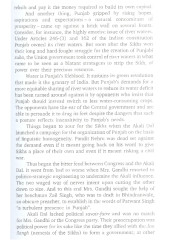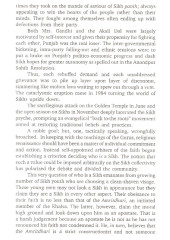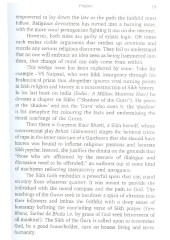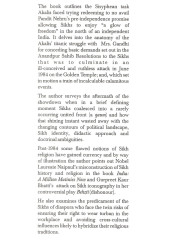Table Of Contents For 'Punjab - A Cataclysmic Showdown - Aftermath and Challenges' Book By Bhupinder Singh Mahal
CONTENTS
|
|
Foreword -Shinder S . Thandi |
9 |
|
|
Preface |
15 |
|
1. |
1984 : The Sequel to Mahabharata |
21 |
|
2. |
Campaign to Recast Sikh Image by Sikhs of Diaspora |
84 |
|
3. |
V.S. Naipaul's Misconstruction of Sikh History |
103 |
|
4. |
Cross-cultural Influences and Doctrinaire
Ambiguities Bedevil the Sikhs
|
130 |
|
5. |
Identity, the Conundrum of Diasporas |
145 |
|
6. |
Attacking the Iconography of Sikh Faith |
157 |
|
7. |
In the name of Whose God ? |
166 |
|
|
Index |
181 |
Preface To Book 'Punjab - A Cataclysmic Showdown - Aftermath and Challenges' By Bhupinder Singh Mahal
Sitting nestled in the north-west peninsula of India undivided Punjab served as a gateway for peoples of central Asia from antiquity. A prairie-like geographical region with rich soil
, lush valleys, five rivers - from whence it derives its name-it is one of the earliest settlements of mankind.
Wave after wave of nomadic and pastoral people of the central Asian steppe came. First to arrive were the Aryans, then came the Scythians followed by the White Huns. Each wave
settled down or moved onwards to other regions to the south or eastwards towards the Indo-Gangetic plains.
Then the invaders came, not to settle but to colonize. Alexander the Great was the first to invade but was forced to turn back when his troops refused to cross Beas. Much later,
when Islam was in its ascendancy, the Pashto Afghan battled their way to establish their sultanate in Delhi. Hordes after hordes of Afghan plunderers followed and left with their
booty.
The paradigm shift came when the descendants of Genhis Khan, competing for central Asian hegemony, drove the loser Babur into India to establish the Mughal dynasty. At about
same time Guru Nanak denounced idol-worship, superstitions, empty rituals and preach the Doctrine of One God and truthfulness.
The message was pure rapture for the people of Punjab who embraced the new dogma and came to be Known as Sikhs of the Guru. The Gurus were to inculcate in their Sikh
followers a sense of egalitarianism, brotherhood, valour, sacrifice, pride and service to mankind.
Sikh Gurus lived and preached in Punjab and the place from whence they waged war against the oppression of the Mughals to free their people, Sikh misls eventually drove away
the Mughals and established Khalsa hegemony, which , in turn, was to morph into the Sikh empire under Maharaja Ranjit Singh.
Punjab was to witness the rise of Sikh Power; and, its eventual fall to the British. The British understood that soldiering and farming came naturally to the Sikh, which is why they en
listed the Sikhs in their army and granted 'jagirs' to others that was to usher in the 'green revolution'.
Those very twin qualities were to bolster both the image of Sikhs in particular and of Punjab in general. The very elements that were to persuade Pandit Jawaharlal Nehru, the first
Prime Minister of India, to promise Sikhs" a glow of freedom" in return for making common cause with the Hindus during independence talks with the British. A promise broken soon after India gained her independence that was to set in motion a chain of calamitous events that pitted Punjabi-Hindu against the Sikh, Central government against Punjab and Mrs.
Indira Gandhi against the Akali Dal, the main Sikh Political party.
Against all these odds, it was Sikh ingenuity, hard work and innovativeness that were to create a society of affluence. But prosperity was to turn into a double-edged sword
For one thing, the increasingly apparent well-to-do visibility of the Sikhs made them unwitting victims of Hindu envy who attributed such prosperity to the largesse of the Centre. Sucha flawed notion of Sikhs as a "pampered minority" steeled Punjabi-Hindu resolve to constrain delivery of key economic programs and or locating of productive assets -
petrochemical plants, sugar and mills, and other vital infrastructure - away from Punjab to other favoured states; and exert undue influence on Central government's political initiatives e.g. Haryana's refusal to forego its claim on Chandigarh - long promised by Union government as capital of Punjab - until Punjab gave Haryana title deeds to Abohar and Fazilka
tehsils and pay it the money required to build its own capital.
And another thing, Punjab gripped by rising hopes, aspirations and expectations - a natural concomitant of prosperity - came up against a brick wall on several fronts. Consider, for
instance, the highly emotive issue of river waters. Under Articles 246-(3) and 162 of the Indian constitution Punjab owned its river waters. But soon after the Sikhs won their long andhard-fought struggle for the creation of Punjabi suba, the Union government took control of river waters in what came to be seen as a blatant stratagem to strip the Sikh, of power over their precious resource.
Water is Punjab's lifeblood. It sustains its green revolution that made it the granary of India. But Punjab's demands for a more equitable sharing of river waters to reduce its water
deficit has been turned around against it by opponents who insist that Punjab should instead switch to less water - consuming crops. The opponents have the ear of the Central government and are able to persuade it to drag its feet despite the dangers that such a posture reflects insensitivity to Punjab's needs.
Things began to sour for the Sikhs when the Akal Dal launched a compaign for the organization of Punjab on the basis of linguistic homogeneity. Pandit Nehru was dead set againstthe demand even if it meant going back on his word to give Sikhs a place of their own and even if it meant risking a civil war.
Thus began the bitter feud between Congress and the Akali Dal. It went from bad to worse when Mrs Gandhi resorted to politico-strategic engineering to undermine the Akali
influence. The two waged war of nerves intent upon cutting the other down to size. And to this end Mrs Gandhi sought the help of her henchman Zail Singh, who was to draft in
Bhindranwale, an obscure preacher, to establish in the words of Patwant Singh " a turbulent presence in Punjab".
Akali Dal lacked political savoir-faire and was no match for Mrs . Gandhi to the Congress party. Their preoccupation was political power for its sake like the time they allied with the
Jan Sangh ( nemesis of the Sikhs ) to form a government; at other times they took on the mantle of saviour of Sikh panth ; always appealing to win the hearts of the people rather
than their minds. They fought among themselves often ending up with defections from their party.
Both Mrs. Gandhi and the Akali Dal were largely motivated by self-interest and given their propensity for fighting each other, Punjab was the real loser. The inter-governmental
bickering, intra-party falling-out and ethnic tensions were to put a brake on Punjab's politico-economic progress and dash Sikh hopes for greater autonomy as spelled out in the
Anandpur Sahib Resolution.
Thus, each rebuffed demand and each unaddressed grievance was to pile up layer upon layer of discontent, simmering like molten lava waiting to spew out through a vent. The
cataclysmic eruption came in 1984 turning the world of Sikhs upside down.
The sacrilegious attack on the Golden Temple in June and the open season on Sikhs on November deeply lacerated the Sikh psyche, prompting an evangelical "back to the roots"
movement aimed at restoring traditional beliefs and practices.
A noble goal; but, one, tactically speaking, wrongfully broached. In keeping wiith the teachings of the Gurus, religious renaissance should have been a matter of individual comm
itment and action. Instead self-appointed arbiters of the faith began establishing a criterion deciding who is a Sikh. The notion that such a value could be imposed arbitrarily on the
Sikh collectivity has polarized the debate and divided the community.
This very question of who is a Sikh emanates form growing number of Sikh youth who are choosing a clean-shaven visage. These young men may not look a Sikh in appearance
but they claim they are a Sikh in every other aspect. Their obeisance to their faith is no less than that of the Amritdhari, an initiated member of the Khalsa. The latter, however, claim
the moral high ground and look down upon him as an apostate. That is a harsh judgement because an apostate he is not as he has not renounced his faith nor condemned it. He, inturn, believes that the Amritdhari is a strict constructionist and not someone empowered to lay down the law or the path the faithful must follow. Religious devoutness has turned intoa burning issue, with the more vocal protagonists fighting it out on the internet.
However, both sides are guilty of eristic logic. Oft times each makes risible arguments that ratchet up emotions and muzzle any serious religious discourse.They fail to understand thatno one will embrace an idea seen as being hammered into them, that change of mind can only come from within.
This wedge issue has been exploited by some. Take for example - VS Naipaul, who sees Sikh insurgency through his Brahminical prism that altogether ignores vital turning pointsin Sikh religion and history in a misconstruction of Sikh hstory. In his last book on India ( India : A Million Mutinies Now ) he devotes a chapter on Sikhs (" Shadow of the Guru"). Hepeers at the 'shadow' and not the 'Guru' who casts it; the 'shadow' in his metaphor for colouring the facts and undermining the moral teachings of the Gurus.
Then there is Gurpreet Kaur Bhatti, a Sikh herself, whose controversial play Behzti (dishonour) stages the heinous crime of rape in the inner sanctum of a Gurdwara that she should have known was bound to inflame religious passions and lacerate Sikh psyche. Instead, she justifies the drama on the grounds that "those who are affronted by the menace of dialogue and discussion need to be offended;" an outburst out of some kind of machismo reflecting insensitivity and arrogance.
The Sikh faith embodies a powerful spirit that can stand scrutiny from whatever quarter.It was meant to provide the individual with the moral compass and the path to God. The
teachings of the Gurus seek to inculcate a spirit of altruism into their followers and imbue the faithful with a deep sense of humanity befitting the concluding verse of Sikh prayer (TereBhane, Sarbat da Bhala i.e. by grace of God seek betterment of all mankind ). The Sikh of the Guru is called upon to remember God, be a good householder, earn an honest living and serve humanity.
About The Author 'Punjab - A Cataclysmic Showdown - Aftermath and Challenges'
Bhupinder Singh Mahal has written extensively for Sikh journals, newspapers and magzines in Canada, United States, England and India on Sikh ethos in general and evolving
situation and challenges facing Sikh diaspora in particular.
He has lived and or worked on five continents. His international manifold experience has provided him with a platform to promote multiculturalism in Canada. From 1990 to 1994
he served on the Canadian Multiculturalism Advisory Committee, a body responsible for policy development in the elimination of barriers to achieve social, cultural and economic
equality for all Canadians.
Since 1997 he has been playing a very proactive role in the health care arena: serving four years as Vice Chair of a leading health provider organization and by serving on the
Council of the College of Physiotherapists, both Order-in-Council appointments by the Ontario government.
In March 2009 Mr. Mahal was appointed Chairperson, Employment Insurance Board of Referees (a Governor-in-Council appointment ). The legislatively prescribed Board is a first
-level, independent, administrative tribunal mandated to provide fair and impartial quasi-judicial hearings of appeals of Employment Insurance decisions.
In 2003 he was awarded the Queen's Golden Jubilee Medal, created to mark the 50th anniversary of the accession of Queen Elizabeth II to the throne, for contribution to Canada,
to the community and to fellow Canadians.
In 2007 he was awarded Council Award by the College of Physiotherapists of Ontario in recognition of significant contributions ensuring the physiotherapists provide high quality,
competent and ethical services that protect the public interest.
Introduction To Book 'Punjab - A Cataclysmic Showdown - Aftermath and Challenges'
The book outlines the Sisyphean task Akalis faced trying redeeming to no avail Pandit Nehru's pre-independence promise allowing Sikhs to enjoy "a glow of freedom" in the north of an independent India. It delves into the anatomy of the Akali's titanic struggle with Mrs Gandhi for conceding basic demands set out in the Anandpur Sahib Resolutions to the Sikhs that was to culminate in an ill-conceived and ruthless attack in June 1984 on the Golden Temple; and which set in motion a train of incalculable calamitous events.
The author surveys the aftermath of the showdown when in a brief defining moment Sikhs coalesced into a rarely occuring united front ( a qaum ) and how that shining instant wasted away with the changing contours of political landscape, Sikh identity, didactic approach and doctrinal ambiguities.
Post-1984 some flawed notions of Sikh religion have gained currency and by way of illustration the author points out Nobel Laureate Naipaul's misconstruction of a Sikh history and religion in the book India: A Million Multinies Now and Gurpreet Kaur Bhatti's attack on Sikh iconography in her controversial play Behzti (dishonour).
He also examines the predicament of the Sikhs of diaspora who face the twin risks of ensuring their right to wear turban in the workplace and avoiding cross-cultural influences likely to hybridize their religious traditions.

